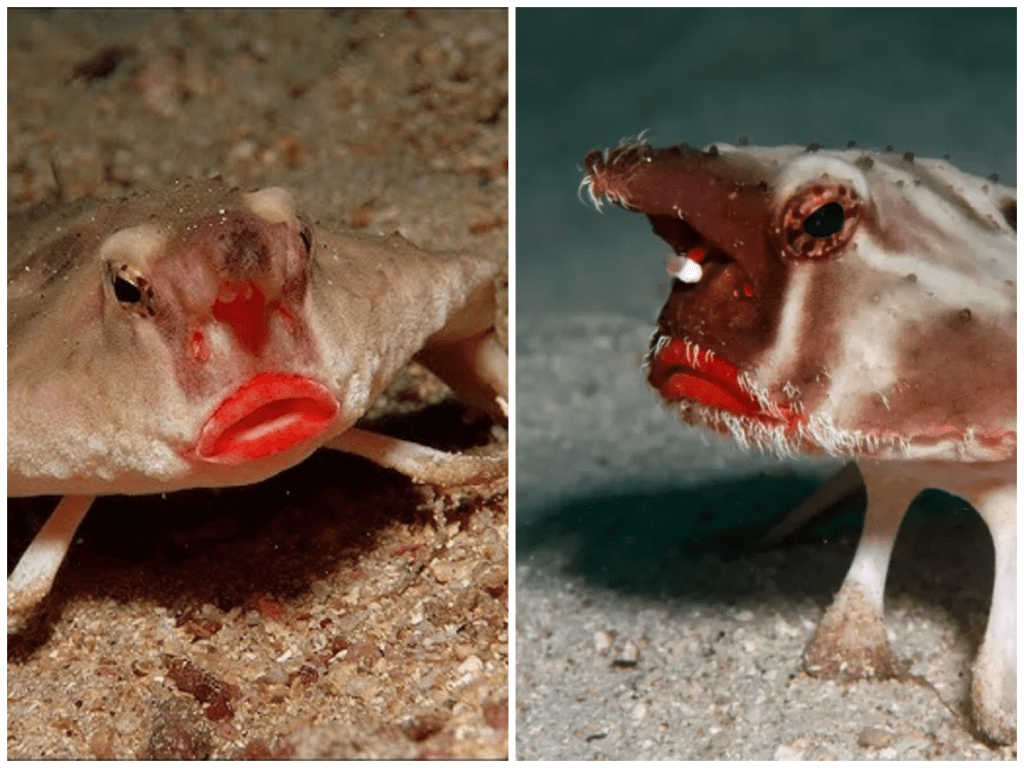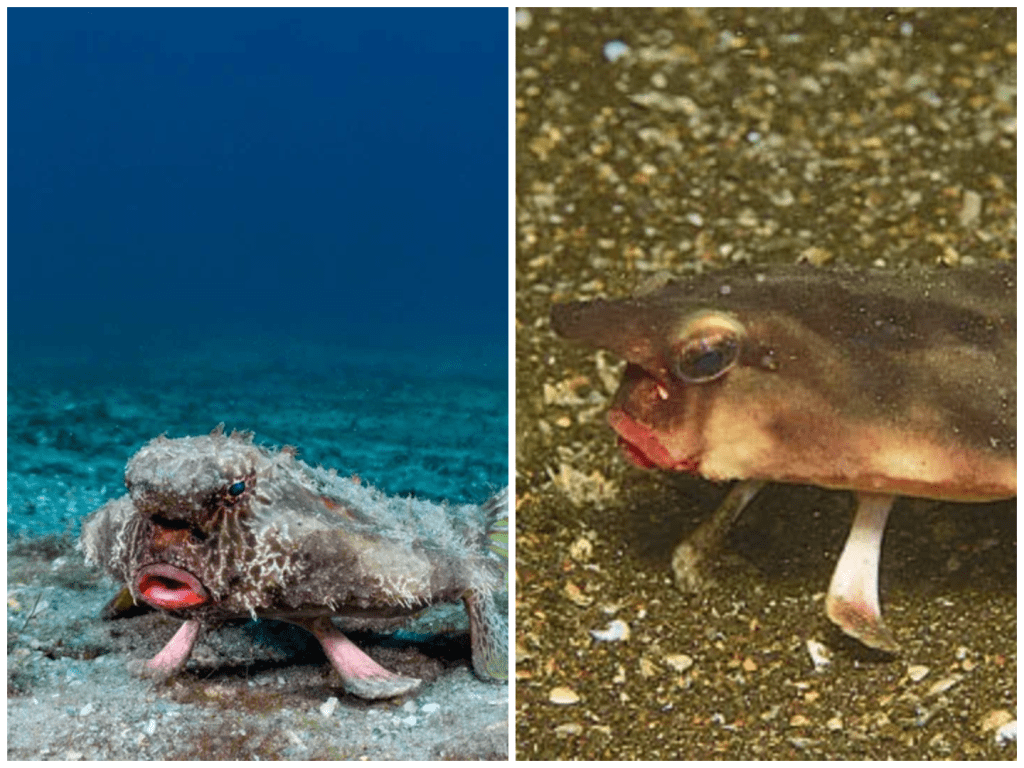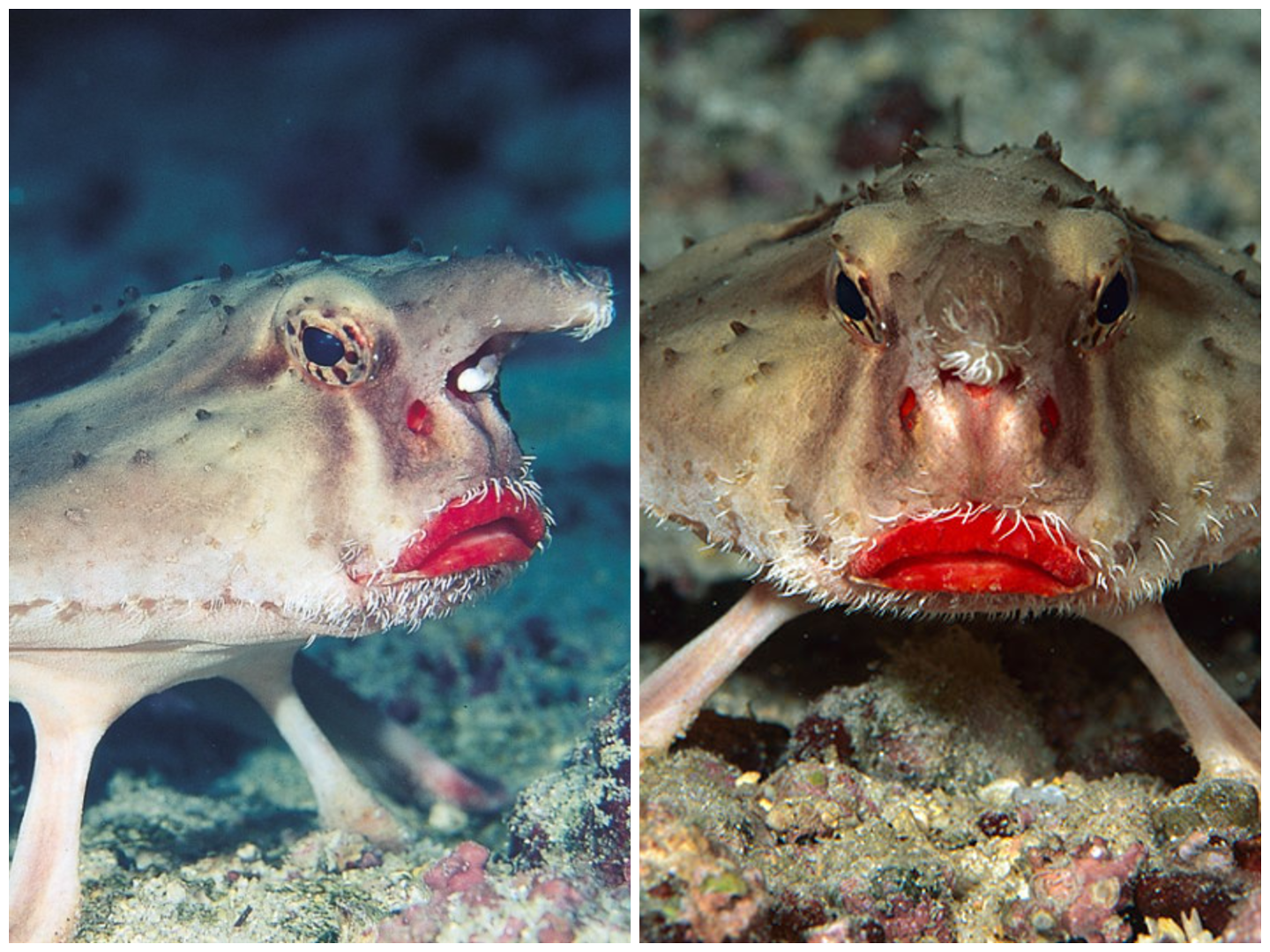The red-lipped batfish of the Galápagos Islands is actually a poor swimmer, so it uses its fins to walk along the ocean floor.

There are creatures in the ocean that glide like ballet dancers, weaving through coral and current as if they were born from water itself. Then, there’s the red-lipped batfish. It doesn’t glide. It doesn’t flow. And honestly, it doesn’t even swim very well. But somehow, that’s what makes it so unforgettable.
Found mostly around the Galápagos Islands and off the coast of northern Peru, the red-lipped batfish isn’t just a curiosity—it’s a statement. With its flattened body, rigid posture, and bright scarlet lips that look like they were borrowed from a makeup ad, this fish is the kind of thing that makes marine biologists do a double take. It looks like a grumpy, underwater alien with lipstick on. And while it might look silly at first, this odd fish has adapted to its world in a way that’s not just fascinating—it’s downright brilliant.
For starters, despite being a fish, the red-lipped batfish is a terrible swimmer. Evolution didn’t give it a streamlined body or powerful tail for long-distance movement. Its fins aren’t shaped for speed, and its posture isn’t made for elegance. If you put it in open water, it would struggle to stay upright, flailing awkwardly like a bird trying to swim. But nature, as always, finds a way.
Instead of trying to be something it’s not, the red-lipped batfish embraced its awkwardness. Rather than swimming through the water like most fish, it decided to walk. Yes—walk.
The red-lipped batfish has uniquely adapted pectoral, pelvic, and anal fins that act like legs. These stiff, limb-like fins press against the ocean floor and help the batfish push itself forward in a slow, clumsy crawl. It’s not graceful. It’s not fast. But it works. Watching one move across the seabed is almost surreal—it’s like watching a creature from another world trying to make sense of ours.

What’s even more incredible is how this fish has turned that strange movement into a strength. Instead of wasting energy trying to chase prey or swim long distances, the red-lipped batfish tends to stick close to the seabed, blending into the rocky and sandy environment. It can lie in wait, barely moving, sometimes using a small lure on its head to draw in unsuspecting prey. That little lure, known as an illicium, is a common feature in anglerfish relatives—and yes, the batfish is part of that strange family tree.
So here’s this oddball of evolution—bad at swimming, with lipstick-red lips, crawling across the ocean floor like it’s out on a mission—and somehow, it’s thriving. It’s not trying to outswim predators. It’s not trying to be sleek or stealthy. It’s just doing its own thing in a world that usually rewards speed and strength. And maybe that’s why people are so fascinated by it.
When photos of the red-lipped batfish pop up online, reactions range from disbelief to laughter. Some think it’s fake. Others think it’s some weird creature from a movie. But the more you learn about it, the more you realize how much there is to admire. Its lips, for instance, aren’t just there for show. While scientists still debate the full reason behind the red coloring, many believe it plays a role in mating or communication. In the deep, muted colors of the ocean floor, those red lips are loud. They send a message. And in the animal kingdom, visibility often means confidence.
There’s something kind of poetic about this fish. It doesn’t fit the mold. It doesn’t care about looking graceful or acting like the rest. It walks when it’s supposed to swim. It flaunts lips that look cartoonish. It lives in one of the most biodiverse ecosystems on Earth, surrounded by predators and competitors, and yet—it endures. It has a niche, a way of life, a rhythm that doesn’t match the rest of the ocean’s song, but still somehow belongs.

In a strange way, the red-lipped batfish reminds us of ourselves. It struggles with movement, it wears its odd features proudly, and it finds creative ways to survive. It teaches us that you don’t have to be the fastest or the strongest to matter. You just have to adapt. You just have to be exactly what you are, and make that work.
It’s easy to overlook creatures like this in the grand catalog of nature’s wonders. The world is full of majestic sharks, glowing jellyfish, vibrant reefs, and mysterious deep-sea monsters. But every once in a while, we get a quiet reminder that weird can be wonderful. That awkward can be powerful. That a fish with no swimming talent can still walk its way into our imaginations.
The Galápagos Islands are no strangers to evolutionary oddities. They’ve been inspiring science since Darwin’s time. But even among all the turtles, iguanas, and strange seabirds, the red-lipped batfish manages to steal the spotlight in its own peculiar way. It’s not just a fish—it’s a living example of how nature doesn’t always follow the rules we expect. Sometimes, it makes something entirely different. Something strange. Something unforgettable.
So the next time you think of the ocean as a place of sleek predators and flowing movement, remember the fish that didn’t get the memo. The one that stumbles instead of soars. The one that made walking underwater look almost natural. The one with the bright red lips and the don’t-care attitude. The red-lipped batfish is out there, shuffling its way across the ocean floor, reminding us that there’s more than one way to be alive—and more than one way to be remarkable.

Daniel Reed is a curious mind with a passion for breaking down how the world works. With a background in mechanical engineering and digital media, he turns complex ideas into easy-to-understand articles that entertain and inform. From vintage tools and modern tech to viral internet debates and life hacks, Daniel is always on the hunt for the “why” behind the everyday. His goal is simple: make learning feel like scrolling through your favorite feed — addictive, surprising, and fun.
